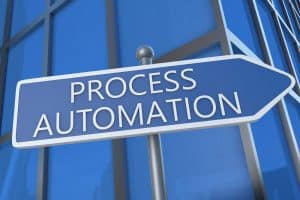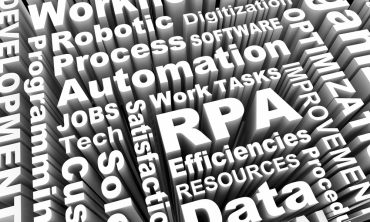
The automation of business processes using robotic process automation (RPA) can be a very efficient solution for repetitive tasks and for companies facing different transitions.
The ongoing trend of digitalization has forced companies to be agile in development and customer support activities in order to be competitive in their industry. Nowadays, competitiveness demands efficiency in different operations, and businesses have to reconsider their ethics to fit the modern digital era. Digital automation with robotic process automation (RPA) is one promising way for enterprises to automate tasks and thus manage work seamlessly and create cost-efficiency. Their so-called “bots,” or non-invasive software robots, work according to certain rules that are created by developers. Also, other innovative technologies, such as artificial intelligence (AI), Machine Learning (ML), Big Data, and much more, can be used within RPA to enable the use of bots in more complicated activities.
See also: Are You Getting the Best Results from RPA?
What is Robotic Process Automation (RPA)?
RPA refers to a software-based solution programmed to carry out procedures, processes, or tasks in the repetitive way that are usually done by humans. RPA is a certain type of automation that involves software combined with machine learning and AI rather than using physical robots. It designs an intelligent software-oriented robotic digital workforce to automate routine and manual data-intensive tasks. Further, with the evolution of cognitive computing and artificial intelligence, the RPA technology progresses into more value-adding creativities.
These virtual workers run rule-based processes with enhanced accuracy and efficiency. Unlike traditional automation methods, RPA includes the power to understand and adapt to changing situations, circumstances, and exceptions. Once the RPA software is prepared to capture & understand the workflow of certain processes in the software application, then it can use data, trigger response, initiate new actions, and interact with other systems independently.
The most notable fact about the RPA system is that it doesn’t demand enterprises to make extreme modifications in their back-office technologies or strategic processes. Even if enterprises deal with various technological systems and split up geographically, the RPA process can connect their systems. Hence, there is no doubt that RPA can function as a minimal risk and cost-effective solution for process automation as well as optimization with promising payback.
What is the importance of robotic process automation?
RPA is capable of addressing various issues at multiple levels in the organizational hierarchy, and at the same time, organizations can face various challenges while employing RPA techniques.
Some basic concerns that every organization have while employing RPA are:
- Induction of insecurity among workers
- Fear of losing confidential information by hacking or by system crash
- Uncertainty, whether the bot will respond to customer needs as efficiently as an employee
- Proactive planning is needed
- Employees must learn how to adapt to working alongside robots
Below are a few reasons why employing RPA could be a great option for several organizations.
- Minimize the human errors
- Maximize the accuracy
- Minimize the time taken to perform repetitive jobs by human employees
- Capability to work continuously
- Reduction in the human workforce
- Increase in the digital workforce
- Increased capability of handling large data sets etc
Employing RPA for any business firm gives many advantages, including:
Accuracy: Since the entire function is handled by software bots, almost all types of human errors are completely erased. The increase in accuracy eliminates rechecking of processed tasks, therefore, saves a lot of time for enterprises.
Ensured Security: Highly confidential tasks such as government file processing or data from law firms can be efficiently processed without any human interference. Since these RPA bots perform only the tasks that they are programmed to do, they will not become a threat to other confidential factors.
Low Technical Barrier: Because the RPA bot works on a predefined code, an employee with low technical knowledge or low coding knowledge will also be able to configure a bot with the help of RPA development tools.
Consistency: Bots can perform the same task repetitively for hours or even days with the same accuracy and efficiency without getting tired or hampering the performance.
Human resource utilization: Manpower can be utilized more fruitfully. The personnel who were previously engaged in doing repetitive mundane tasks can now be assigned to some more creative jobs.
Quality of service: RPA can certainly improve the quality of services provided by a business with increased efficiency and accuracy.
Reliability: Bots can apply rules without fail, perform certain tasks without making mistakes, and do not change the course of action in different iterations.
The different tools that businesses should leverage
Automation Anywhere
Automation Anywhere is one of the leading and trusted service providers for efficient RPA tools. The architecture of Automation Anywhere is client/server-based. Some additional features of automation anywhere are:
- Bot insights, which is an analytics engine that allows users to visualize user data and take business insights from it.
- Bot farm, which allows companies to buy RPA tools on a usage basis rather than on a capacity or license basis.
- Bot store, which is Automation Anywhere’s marketplace where various plug and play bots are available.
UiPath
UiPath is a global software company that provides a platform to develop software bots for automating business processes. It is a web orchestrator-based architecture that is created on a .NET framework.
There are three main components of this innovative RPA tool:
- Studio
- Orchestrator
- Robots
The UiPath studio presents various solutions and workspaces to seamlessly design and create user-defined bots. It is easier to use since it uses a drag and drop approach while working with activities. The orchestrator allows the user to upload a bot in the cloud, deploy it and manage its resources.
BluePrism
Similar to Automation Anywhere, BluePrism is also another leading RPA service provider that is focussed on RPA solutions and RPA tools. It is based on Java & .NET frameworks and provides a drag and drop approach for bot designing.
The four main components of BluePrism are:
- Process Diagram
- Process Studio
- Object Studio
- Application Modeler
BluePrism also provides a control room for analyzing bot activities and audit trails. It has also integrated cross-platform support for many other AI and cloud technologies. Work queues are used for workload management for managing the execution of multiple bots simultaneously.
BluePrism also supports intelligent surface automation, multi-language interface support, customized dashboard, robot screen capture, and more.
Last word
The automation of business processes using robotic process automation (RPA) can be a very efficient solution for repetitive tasks and for companies facing different transitions. This innovative solution is also easily adaptable for organizational changes or system changes since they can be directly implemented from the cloud service models. Relatively low prices of the licenses and a potentially big cost reduction qualify RPA services as a good option for companies aiming to lower down the operational costs and risks.




























